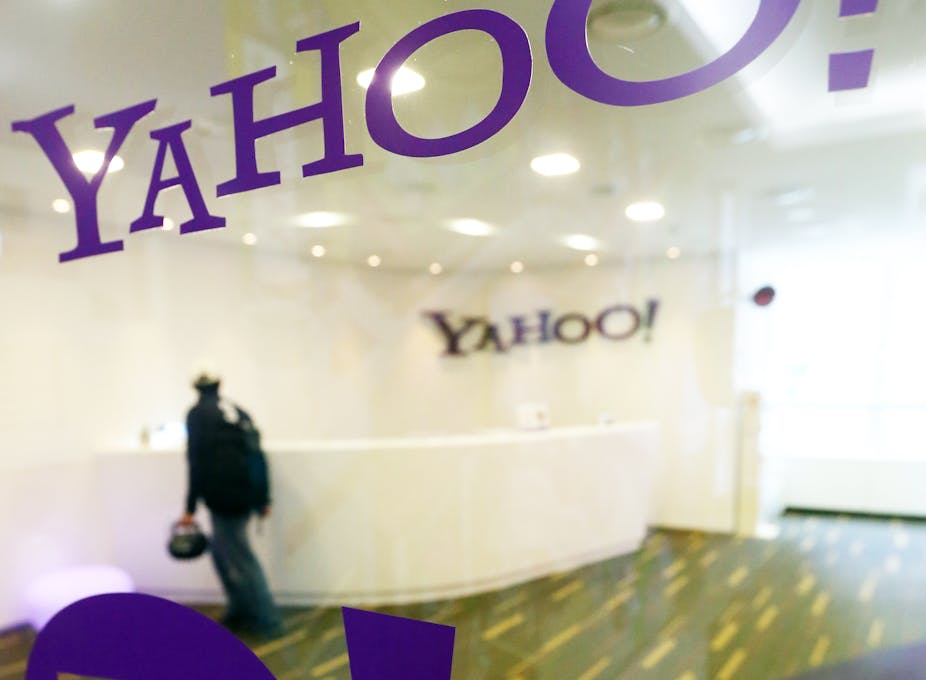An internal memo to Yahoo employees has created quite a stir in the press and in social media outlets of late, questioning the leadership direction of Yahoo CEO Marissa Mayer.
According to reports, from June this year, Yahoo employees who have been allowed to work from home will now need to make themselves present in the office to enhance collaboration, interaction and innovation in the company.
Yahoo’s plan has been met mostly with outrage and mild puzzlement. I’m always wary of media frenzy over the actions of leading female business figures and politicians because I’m often concerned that their decisions are judged through the lens of sexism.
Nevertheless, this is an interesting case for a number of reasons – because it reveals underlying tensions in a three decade old pattern of decentralising knowledge work and workers out of the office workplace (and increasingly out of the country).
Since the 1970s there have been competing visions of “the mobile and flexible office”. Telecommunication and mobile operators take advantage of the shift away from the office afforded by mobile and networked technologies to promote ideals of flexibility, freedom and enhanced productivity (“anywhere, anytime work”).
Building designers and architects propose an alternative vision: focusing on the benefits of collaboration, interaction and innovation within the workplace (“Alternative workplacing”, “activity-based working” and such like).
The memo and policy it describes reinforces the sense that these are opposing models of organisation and that the two can’t work together but I’m sure employees of Yahoo who have had flexible work arrangements have been benefiting from both models and experiencing their mutual pitfalls. What is really behind this recent reaction against supporting flexible working?
On the surface there is the perceived advantage that companies are able to capture and leverage more value from employees who are ‘present’ in the office and for longer periods of time. Indeed, this is an implicit objective clearly signalled by campus style office designs that supply fridges, beds, lounges, pool tables and other ‘fun stuff’.
But while the memo argues that innovation, collaboration and interaction are the outcome of being present at work - bumping into one another in corridors, at the water-cooler and peeking over partitions – this claim doesn’t stand up to further scrutiny.
Let’s consider the following six points. First of all this stance negates that virtual presence of employees (whether flexibly located or not) is an important factor in organisational communication and collaboration. Water cooler interactions (even when in the office) can these days take place as much in email exchanges, Skype chats, Twitter feeds and Facebook updates.
Secondly, it assumes that employees who are not physically present are contributing less. But how is this measured? Has it been evaluated at Yahoo and if so, what are the results? Studies that have been conducted in this area have shown that workers working from home or in other locations contribute more or the same as their workplace counterparts. Indeed, many work overtime partly to compensate for their lack of presence and partly because they can through their networked and mobile digital technologies.
Thirdly, it assumes that if we don’t know what these workers are contributing then this must be a problem with them not being present – rather than it being a matter of supervision, communication and better support – a point made by Sara Sutton Fell writing in The Huffington Post.
Fourthly, the assumption that simply extracting more time and ‘presence’ from employees will increase productivity, is misleading and false. Undoubtedly, there are times when putting in extra time may be required for particular tasks or project phases, but creating an organisational culture of constant presence and work can lead to a poor sense of well being and inefficiencies and not necessarily to any of the qualities that the memo identified as important to an innovator of new ideas and technologies.
Fifthly, it applies selectively only to those workers for whom flexible work is a formal component of their jobs. I’m guessing that those who work flexibly outside of these hours continue to be encouraged to do so, from wherever they happen to be – no doubt through the free iPhone 5’s that Yahoo generously supplied their employees.
Finally, there is inherent inequity at the heart of this decision. For some employees, particularly those with caring responsibilities, this will mean they will lose out on the very conditions that allow them to work, participate and innovate in the first place.
Teasing out this event tells us a few things:
Yahoo’s response is unlikely to solve the perceived problem identifed in the memo - the need for more collaboration, interaction, innovation - because it doesn’t look seriously at where and how these qualities are produced.
It is a huge diversion from possibly other more serious structural or external barriers and problems that Yahoo as a company is facing.
From an employee perspective, it simply represents another effort in the established arsenal of management strategies to extract more ‘time’ and ‘effort’ from employees, this time through spill-in and surveillance: bringing workers bodies and actions into the field and gaze of the organisation.
Perhaps most importantly - it is a backward step in the development of flexible work arrangements that really can work for organisations and employees. High-tech organisations have a history of acting as a testing ground for new ways of working. Because of this, they also have the potential to become ‘best practice’ models (although Yahoo’s chances of this happening are looking grim!).
In the end, Yahoo’s plan is simply an opportunity for different visions of the future of work to be pitted against each other rather than trying to understand the realities, benefits and actual challenges that come with flexible work arrangements in the larger context of a shift to decentralised models of work.

